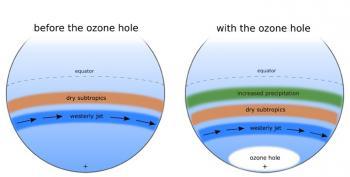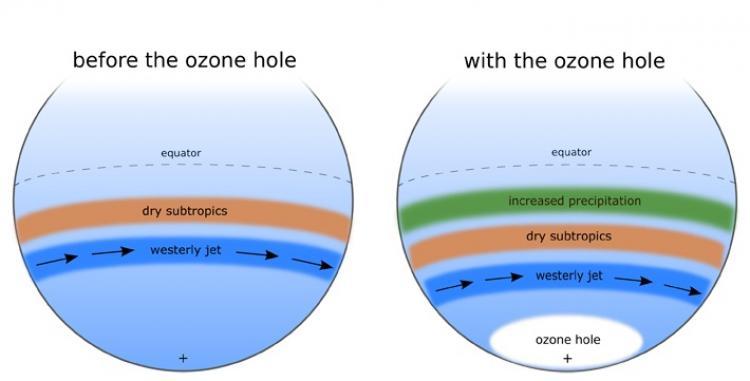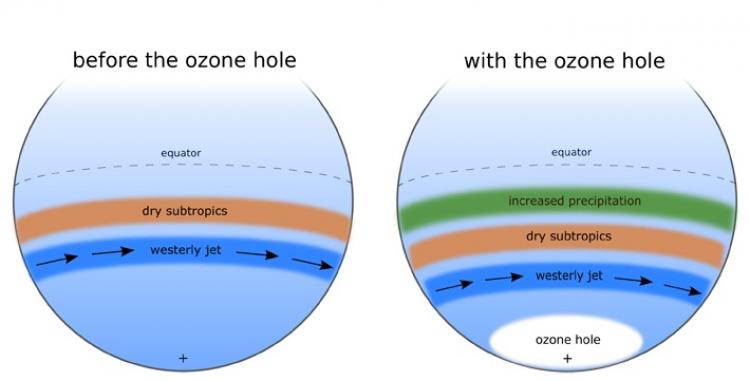The ozone hole over the Antarctic has been linked with climate change in the entire southern hemisphere of the Earth, from the south pole to the equator, according to a study published in Science on April 22.
The ozone layer absorbs harmful ultraviolet radiation from the sun, protecting the Earth’s surface below. Since the 1960s, man-made chemicals such as chlorofluorocarbons (CFCs) from aerosol cans, have damaged the ozone layer and created a hole above the Antarctic, first observed in the 1980s.
By comparing two independent climate models, the researchers found that the ozone hole influences rainfall patterns throughout the southern hemisphere.
“It’s really amazing that the ozone hole, located so high up in the atmosphere over Antarctica, can have an impact all the way to the tropics and affect rainfall there—it’s just like a domino effect,” said lead author Sarah Kang, a postdoctoral research scientist at Columbia University’s Department of Applied Physics and Applied Mathematics, in a press release.
According to the researchers, international agreements about mitigating climate change must consider ozone, as well as carbon.
“The ozone hole is not even mentioned in the summary for policymakers issued with the last IPCC (Intergovernmental Panel on Climate Change) report,” said co-author Lorenzo Polvani, also at Columbia University, and a senior researcher at the Lamont-Doherty Earth Observatory.
“We show in this study that it has large and far-reaching impacts. The ozone hole is a big player in the climate system!” Polvani added. “This could be a real game-changer.”
Ozone depletion has been greatly reduced by stopping CFC production globally via the 1989 Montreal Protocol, and the hole is expected to close by the middle of the 21st century. However, in the interim, the researchers say the hole has contributed to climate change.
“While the ozone hole has been considered as a solved problem, we’re now finding it has caused a great deal of the climate change that’s been observed,” Polvani said.
The scientists now want to research extreme precipitation events, which can cause natural disasters, such as major flooding and mudslides.
“We really want to know if and how the closing of the ozone hole will affect these,” Kang said.
In a recent report from the United Nations’ World Meteorological Organization , researchers from the international organization found that ozone over the Arctic circle experienced its greatest loss yet this last winter. CFCs in the atmosphere were also blamed for the loss of ozone.
The ozone layer absorbs harmful ultraviolet radiation from the sun, protecting the Earth’s surface below. Since the 1960s, man-made chemicals such as chlorofluorocarbons (CFCs) from aerosol cans, have damaged the ozone layer and created a hole above the Antarctic, first observed in the 1980s.
By comparing two independent climate models, the researchers found that the ozone hole influences rainfall patterns throughout the southern hemisphere.
“It’s really amazing that the ozone hole, located so high up in the atmosphere over Antarctica, can have an impact all the way to the tropics and affect rainfall there—it’s just like a domino effect,” said lead author Sarah Kang, a postdoctoral research scientist at Columbia University’s Department of Applied Physics and Applied Mathematics, in a press release.
According to the researchers, international agreements about mitigating climate change must consider ozone, as well as carbon.
“The ozone hole is not even mentioned in the summary for policymakers issued with the last IPCC (Intergovernmental Panel on Climate Change) report,” said co-author Lorenzo Polvani, also at Columbia University, and a senior researcher at the Lamont-Doherty Earth Observatory.
“We show in this study that it has large and far-reaching impacts. The ozone hole is a big player in the climate system!” Polvani added. “This could be a real game-changer.”
Ozone depletion has been greatly reduced by stopping CFC production globally via the 1989 Montreal Protocol, and the hole is expected to close by the middle of the 21st century. However, in the interim, the researchers say the hole has contributed to climate change.
“While the ozone hole has been considered as a solved problem, we’re now finding it has caused a great deal of the climate change that’s been observed,” Polvani said.
The scientists now want to research extreme precipitation events, which can cause natural disasters, such as major flooding and mudslides.
“We really want to know if and how the closing of the ozone hole will affect these,” Kang said.
In a recent report from the United Nations’ World Meteorological Organization , researchers from the international organization found that ozone over the Arctic circle experienced its greatest loss yet this last winter. CFCs in the atmosphere were also blamed for the loss of ozone.






